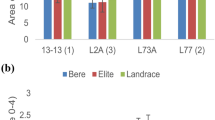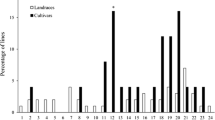Abstract
Disease reactions to specific Rhynchosporium secalis isolates from western Canada were characterized on forty Turkish Hordeum vulgare accessions. One accession, MEH151-1, exhibited resistance against isolate WRS1860 and was also resistant to isolates WRS1493 and WRS1824 which were avirulent to the Rh gene. A related line, MEH151-2 exhibited resistance to WRS1493 but not to WRS1860. Crosses between both MEH151-1 and MEH151-2, and the susceptible cultivar, Harrington, were used to demonstrate a linkage between resistance to WRS1493 and an allele specific amplicon, Falc666. Resistance to WRS1860 imparted by MEH151-1 was mapped to the other side of the Falc666 locus. Falc666 was previously shown to be located near the centromere on the long arm of chromosome 3. Characterization of the genetic basis for the scald resistance phenotype exhibited by these Turkish accessions, coupled with the identification of marker linkages, provides evidence for genetic variation in scald resistance in this chromosomal region.
Similar content being viewed by others
References
Barua, U.M., K.J. Chalmers, C.A. Hackett, W.T.B. Thomas, W. Powell & R. Waugh, 1993. Identification of RAPD markers linked to a Rhynchosporium secalis resistance locus in barley using nearisogenic lines and bulked segregant analysis. Heredity 71: 177–184
Buchannon, K.W. & H.A.H. Wallace, 1962. Note on the effect of leaf diseases onyield, bushel weight and thousand-kernel weight of Parkland barley. Can J Plant Sci 42: 534–536
Dyck, P.L. & C.W. Schaller, 1961. Inheritance of resistance in barley to several physiologic races of the scald fungus. Can J Genet Cytol 3: 153–164
Edwards, K., C. Johnstone & C. Thompson, 1991. A simple and rapid method for the preparation of plant genomic DNA for PCR analysis. Nucleic Acids Res 19: 1349
Goodwin, S.B., R.W. Allard & R.K. Webster, 1990. A nomenclature for Rhynchosporium secalis pathotypes. Phytopathology 80: 1330–1336
Habgood, R.M. & J.D. Hayes, 1971. The inheritance of resistance to Rhynchosporium secalis in barley. Heredity 27: 25–37
Johnson, M., G.A. Penner & A. Tekauz, 1995. DNA fingerprinting of Rhynchosporium secalis pathotypes. Phytopathology 85: 1135 Abstract
Legge, W.G., D.R. Metcalfe, A.W. Chiko, J.W. Martens & A. Tekauz, 1996. Reaction of Turkish barley accessions to Canadian barley pathogens. Can J Plant Sci (in press)
Penner, G.A., A. Tekauz, E. Reimer, G.M. Scoles, B.G. Rossnagel, W.G. Legge, P.A. Burnett, T. Ferguson & J.F. Helm, 1996. The genetic basis of scald resistance in western Canadian barley cultivars. Euphytica (in press, 1996)
Tekauz, A., 1991. Pathogenic variation in Rhynchosporium secalison barley in Canada. Can J Plant Path 13: 298–304
Wells, S.A. & W.P. Skoropad, 1963. Inheritance of reaction to Rhynchosporiumsecalis in barley. Can J Plant Sci 43: 184–187
Author information
Authors and Affiliations
Rights and permissions
About this article
Cite this article
Penner, G., Legge, W. & Tekauz, A. Identification of isolate specific sources of scald resistance in Turkish barley (Hordeum vulgare) accessions. Euphytica 99, 111–114 (1998). https://doi.org/10.1023/A:1018344826383
Issue Date:
DOI: https://doi.org/10.1023/A:1018344826383




